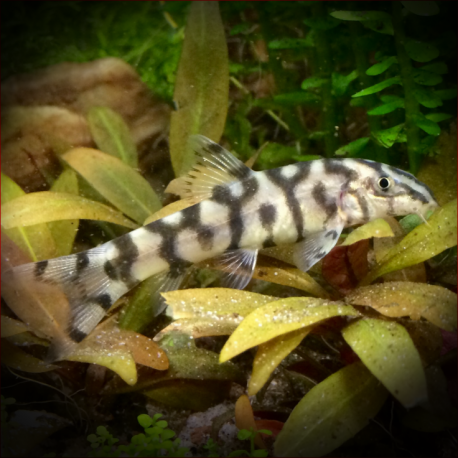More info
Datasheet
| Minimum Tank Size | 270 litres / 71.33 US gallons |
| Maximum Size | 16.0cm / 6.30inches |
| Temperature | 19°C / 66.20°F - 27.5°C / 81.50°F |
| Hardness | 2.02dgH / 36ppm - 12.05dgH / 215ppm |
| pH | 6.0-7.5 |
General Description
B. almorhae, commonly known as the Yo-Yo Loach, is a species of loach categorized under the Cypriniformes order. These loaches exhibit a distinct pattern in their juvenile stage with alternating 'i' and 'y' shaped bars, which break up as they mature. Their coloration ranges from whitish to yellow, golden, or light green, with an adult size of up to 16.0cm. The species is known for its social behavior, forming complex hierarchies and thriving in groups of at least 5 to 6 individuals, preferably more.
Aquarium Setup
When setting up an aquarium for Botia Almorhae, a well-structured environment is crucial. The tank should have a capacity of at least 270 litres and be equipped with smooth, water-worn rocks, fine gravel or sand substrate, driftwood, and branches. Lighting can be subdued, and adding plants like Java Fern, Java Moss, or Anubias is recommended. Providing ample hiding spots and covering gaps to prevent entrapment is necessary. Water conditions should be stable, well-oxygenated, and maintained through regular water changes.
Behaviour
Botia Almorhae is not highly aggressive but may intimidate smaller tankmates due to its size and active behavior. These loaches exhibit social behaviors, forming intricate hierarchies within their groups. Dominance battles are common, and individuals can exhibit a phenomenon known as 'greying out' during such interactions. They also display unique behaviors like 'shadowing,' where younger fish mimic older ones, and the 'loachy dance,' a restless swimming pattern observed in response to various stimuli.
Feeding and Diet
While primarily carnivorous, Botia Almorhae can consume vegetative matter, including aquatic plants, if available. Their diet usually consists of aquatic molluscs, insects, worms, and other invertebrates. A varied diet comprising quality dried products, live or frozen foods like bloodworms and Artemia, along with fresh fruits and vegetables, is recommended. Homemade foods using natural ingredients are also beneficial.
Reproduction & Dimorphism
Breeding reports of Botia Almorhae in captivity are scarce. Commercial breeding often involves the use of hormones, leading to hybrids. Mature females tend to have a fuller body compared to males, showcasing sexual dimorphism. When stressed, these loaches can erect sharp sub-ocular spines, which pose a risk if mishandled.
Habitat and Distribution
B. almorhae is a riverine species found in pools and calm areas with rocky substrates and tends to migrate upstream during spawning. Their distribution includes parts of the Ganges River drainage in northern India and possibly Nepal. This species is often mislabeled as the "Pakistani" loach, despite its restricted range.
Etymology
The species name Botia Almorhae is derived from Almora district, Uttarakhand State, India, its type locality.

